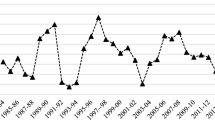Abstract
Little is known about the nature of physical capital in the less-developed countries. This article addresses the lack of empirical study related to depreciation rates, which are a neglected but important ingredient of both micro and macro models and empirical analyses. Based on rich establishment-level survey data, and using a straightforward econometric approach, I estimate depreciation rates of physical capital invested in manufacturing enterprises in Indonesia. I estimate the depreciation rate to be between 8 and 14 %. These numbers compare roughly to published estimates for the U.S. I then investigate hypotheses related to heterogeneity of depreciation rates across different types of firms. Finally, I test the hypothesis that financially constrained firms use less durable investment goods.
Similar content being viewed by others
References
Bai C-E, Hsieh C-T, Qian Y (2006) The return to capital in China. Brook Pap Econ Act 37(2): 61–88
Barro R, Sala-i-Martin X (1995) Economic growth. McGraw Hill, New York
Benhabib J, Spiegel M (1994) The role of human capital in economic development: evidence from aggregate cross-country data. J Monet Econ 34: 143–173
Bigsten A, Collier P, Dercon S, Fafchamps M, Gauthier B, Gunning J, Oduro A, Oostendorp R, Pattilo C, Söderbom M, Teal F, Zeufack A (2002) Adjustment costs and irreversibility as determinants of investment: evidence from African manufacturing. Manuscript
Bond S, Elston J, Mairesse J, Mulkay B (2003) Financial factors and investment in Belgium, France, Germany and the United Kingdom. A comparison using company panel data. Rev Econ Stat 85(1): 153–165
Coen R (1975) Investment behavior, the measurement of depreciation, and tax policy. Am Econ Rev 65(1): 59–74
de Mel S, McKenzie D, Woodruff C (2008) Returns to capital in microenterprises: evidence from a field experiment. Q J Econ 123(4): 1329–1372
Fraumeni B (1997) The measurement of depreciation in the U.S. national income and product accounts. Survey of Current Business, pp 7–23
Hauk W, Wacziarg R (2004) A Monte Carlo study of growth regressions. NBER Technical Working Paper 296
Hsieh C-T, Klenow PJ (2009) Misallocation and manufacturing TFP in China and India. Q J Econ 124(4): 1403–1448
Hulten C, Wykoff F (1981) The estimation of economic depreciation using vintage asset prices. J Econ 15: 367–396
Islam N (1998) Growth empirics: a panel data approach—a reply. Q J Econ 113(1): 325–329
Jorgenson D (1974) The economic theory of replacement and depreciation. In: Sellekaerts W (ed) Econometrics and economic theory. Essays in honor of Jan Tinbergen. White Plains, New York
King R, Levine R (1994) Capital fundamentalism, economic development, and economic growth. Carnegie-Rochester Conf Public Policy 40: 259–292
Kumar S, Managi S (2010) Productivity and convergence in India: state level analysis. Manuscript. University of Delhi, Delhi
Kydland F, Prescott EC (1982) Time to build and aggregate fluctuations. Econometrica 50(6): 1345–1370
Mankiw G, Romer D, Weil D (1992) A contribution to the empirics of economic growth. Q J Econ 107(2): 407–437
McKenzie D, Woodruff C (2008) Experimental evidence on returns to capital and access to finance in Mexico. World Bank Econ Rev 22: 457–482
OECD: (2000) National accounts for China. Sources and methods. Organisation for Economic Co-operation and Development, Paris
Pritchett L (2000) The tyranny of concepts: CUDIE (cumulated, depreciated, investment effort) is not capital. J Econ Growth 5(4): 361–384
Raychaudhuri B (1996) Measurement of capital stock in Indian industries. Econ Policitical Wkly 31(21): M2–M6
Summers R, Heston A (1991) The penn world table (Mark 5): an expanded set of international comparisons, 1950–1988. Q J Econ 106(2): 327–368
Udry C, Anagol S (2006) The return to capital in Ghana. Am Econ Rev Pap Proc 96(2): 388–393
Wang Y, Yao Y (2003) Sources of China’s economic growth 1952–1999: incorporating human capital accumulation. China Econ Rev 14: 32–52
Author information
Authors and Affiliations
Corresponding author
Rights and permissions
About this article
Cite this article
Schündeln, M. Appreciating depreciation: physical capital depreciation in a developing country. Empir Econ 44, 1277–1290 (2013). https://doi.org/10.1007/s00181-012-0592-2
Received:
Accepted:
Published:
Issue Date:
DOI: https://doi.org/10.1007/s00181-012-0592-2




